So you’ve taken the first step and got yourself a small camper.
Maybe it’s for you and your partner, or perhaps you’re bringing a few close friends along. Either way, since you’re reading this, I’m guessing you’re new to towing?
Towing a small camper might be easier than lugging a big fifth wheel around, however, it still takes some time to get used to.
There are safety precautions to take, practicing to do, and making sure you’ve got the right vehicle for the job.
Today I’ve put together 13 tips for towing a small camper. These include everything from what precautions to take to what you can expect when you’re on the road.
Let’s get started!
1. Got The Right Vehicle?
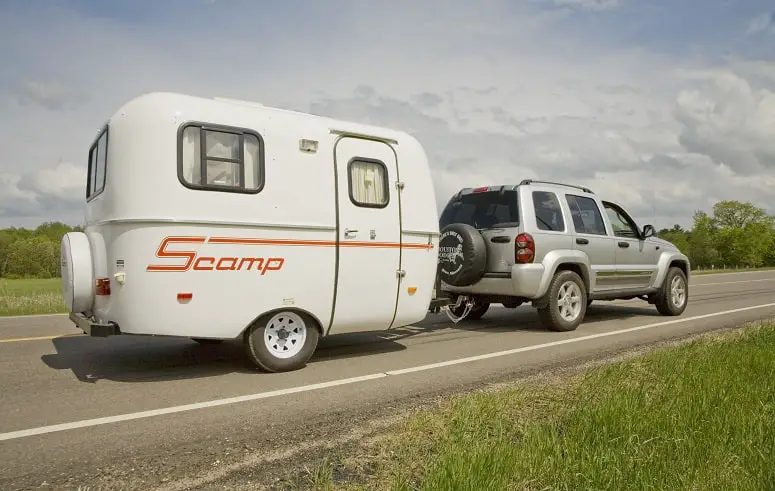
First things first, when towing a camper, it’s best to use a car with rear-wheel drive.
This will put all the power on the correct axle, namely, where most of the weight sits. Front-wheel drive can cause you to lose control of the back of your car.
Regarding your transmission, choose what you feel the most comfortable with.
Some people prefer automatic since it eliminates one extra thing to worry about, and lets you focus on the road ahead.
For a small trailer, you really don’t need the biggest truck out there anymore. In fact, even a motorcycle can pull a teardrop camper — but more on that in a sec.
They are super light.
Thanks to technology, the towing capacity of smaller cars and vans has improved. Most of these now have the appropriate transmissions, horsepower, and torque to tow campers weighing as much as 3,500 pounds!
So this gives you plenty of room to play with when choosing the right ride for you.
You can, of course, still use your heavy-duty truck, but there’s no immediate need.
Before you do anything else, however, make sure that you understand the limit of your vehicle’s towing capacity.
How To Determine The Weight
To determine the best car to do the job, we must get mathematical and calculate some weight.
There are a few things to count other than the tow ratings of your vehicle.
You must consider the total load of the gear as well as the weight of your camper.
Take a look at some average weights of fifth wheel trailers.
Here’s what you need to calculate:
- The Gross Combination Weight Rating (GCWR): the weight of the car plus the full trailer weight.
- The Gross Vehicle Weight Rating (GVWR): the total weight of the vehicle, with passengers, luggage, fuel, etc.

You can use a truck scale at a truck stop, or perhaps ask at the dealer to get the correct numbers.
Once you’ve got the right estimations, you can then calculate the accurate maximum tow rating.
Remember what I said about the motorcycle?
If you’re a motorcycle enthusiast and have a bike with at least 1,000 CC, you can easily tow a 290-pound trailer. There are, of course, some extra safety precautions to take, such as using a swivel hitch.
2. Hitch Correctly
Now that you’ve got your trailer and your tow vehicle, it’s time to hitch them together.
Here are a few different hitches you can use to tow your small camper.
Rear Receiver Hitch
The rear receiver hitch is probably the most commonly used for small campers.
A rear receiver hitch will connect to the back end of your car. The receiver tube is square, so this means you can attach it to a variety of hitch setups.
These come in five different weight classes. For a small camper, you will do just fine with a Class I hitch. This one can handle up to approximately 2,000 pounds.
However, if you think you might be upgrading your trailer to a bigger one, get a Class II or even a Class III.
Gooseneck Hitch
If you drive a pickup truck, a gooseneck hitch would be the one for you.
These are very similar to what you’d see in a fifth wheel hitch. A gooseneck hitch, however, uses a ball and coupler, as opposed to the fifth wheel king pin lock.
Gooseneck hitches are excellent if you think you might upgrade your camper down the line. People often use these for horse or livestock trailers, due to their durability.
The hitch itself can attach either above or below the truck bed. If you keep the ball out of towing position, you’ll still have loads of space in the back.
Pintle Hitch
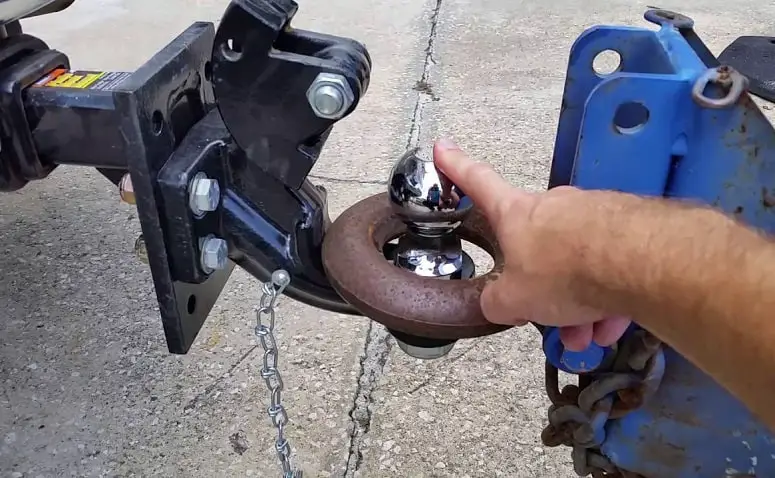
Again, if you’re thinking that you might upgrade your trailer, or if you will be going through rough terrain, this is your hitch. These look a bit different than your typical hitch.
They use a ring-to-hook or ball configuration. The pintle itself can somewhat resemble an oversized wrench.
This hitch is excellent for heavy duty towing. It can pull a 60,000-pound trailer, that’s the same as a large truck! Still, they’re not the choice for everyone, since they can be quite noisy.
Weight Distribution Hitch
A weight distribution hitch is another good choice if you drive a pickup.
These will even out the weight at the tongue, so the rear of the trailer and front of the car stay level.
If there’s too much weight near the tongue, the overall shape of the vehicle and trailer will resemble a banana. A weight distribution hitch will divide the weight, allowing for a smoother and safer ride.
Bumper Hitch
A bumper hitch is very versatile.
It hooks onto the bumper as opposed to the frame. These can tow a variety of trailers weighing up to 5,000 pounds.
So if you also have a small boat, or horse trailer that needs a mode of transport, this is your hitch. Also, if you were to install a weight distribution system along with this hitch, you could pull up to 6,000 pounds.
Before You Hitch
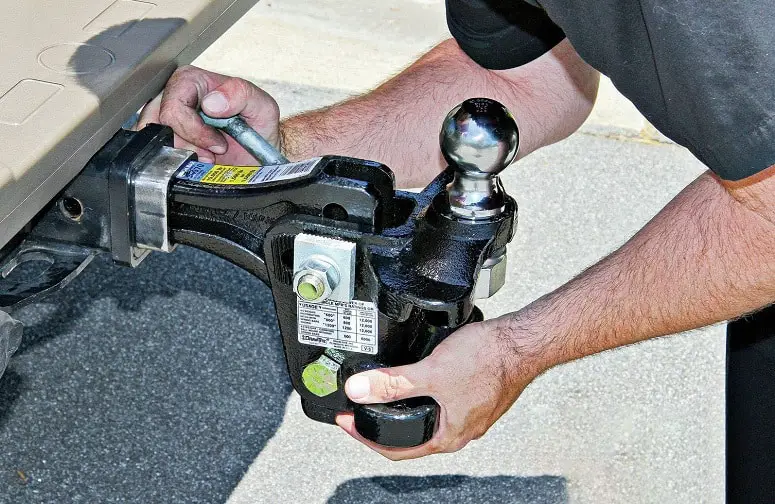
Before you get started, there are a couple of precautions to take.
- Turn off all appliances and disconnect utilities.
- Raise the steps and stabilizers.
- Remove the hitch lock.
- Place the receiver latch in the vertical open position.
- Raise the front of the trailer (you can use a jack piston).
Get Hitched: place the hitch on the vehicle close to the receiver on your trailer. Then gently slide them together and secure them.
The next thing on our checklist is to connect the brakes and lights. These lights are a necessity when you signal your next moves to other drivers on the road. Then there’s the emergency brake.
This is designed to prevent your camper from running away in the off chance it disconnects from your vehicle. You attach this to the loops on the safety chains.
And last but not least, the safety chains. These are here to keep your camper attached if the hitch should fail, or if you forget to lock it. Secure them in the hooks on your hitch, or as the instruction manual tells you to.
Make sure they’re not too long. They should hang freely but not drag on the ground, nor should they be too tight.
Here is a quick video to give you a visual guide.
3. Know Your Height
Now that you’ve got your camper securely lugging behind you, the clearance needed for your new height increases if the camper is higher than your vehicle.
You don’t want to get stuck or, even worse, wreck your camper or the low-clearance bridge.
A good idea is to write down the height of your camper on a sticky note. Add about a foot to that, and you should be clear. Stick it to the dashboard, and you’ll be ready when warnings for low clearances approach.
If you plan to travel across borders and into Canada for example, write down your measurements in centimeters and meters as well. This way, you’ll avoid having to do a quick calculation at the last minute.
Be mindful when pulling into gas stations or driving near vegetation. Gas stations usually have a clearance sign, but trees don’t!
Long and heavy branches hanging near or over the road can cause severe damage to your trailer. Use your sharp eyesight and make a quick evaluation to determine if you can pass through, or if you should find another route.
4. Check The Visibility
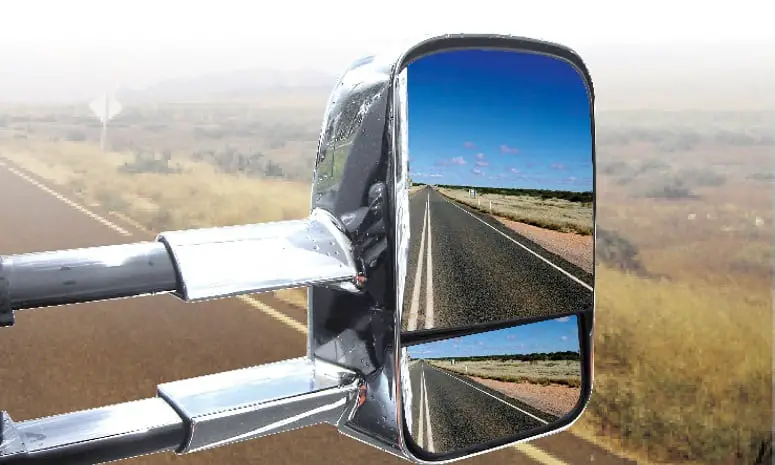
With a camper hauling behind you, your side mirrors may not provide the best rear view.
Accidents are more likely to happen when you have a huge blind spot behind you. Therefore, many camper owners opt for buying new mirrors.
There are two options—either get your side mirrors permanently extended, or invest in some clip-ons.
This will really provide you with some much needed rear view while driving.
Clip-ons are an excellent choice if you’re not planning to become a frequent camper.
Instead of extended mirrors, you could also invest in rear-vision cameras.
The lens will attach at the end of your camper, with a monitor usually situated on the dash. This allows you to observe what’s going on at the back.
The only downside is that cameras are a pricey addition. However, I do feel that they’re worth considering.
The camera will give you an overall look that will undoubtedly come in handy, especially when making maneuvers such as backing up and lane changes.
5. Check The Brakes
Before you get going, there is one crucial thing to check.
It’s your brake controller.
While the brakes on your vehicle are working, you need some backup for when it comes to stopping the trailer.
Brake controllers connect to your car and should activate automatically when you brake. At the moment there are two choices—a proportional brake controller, and a time-delayed controller.
A proportional brake controller is the most automated, since it will adjust to how you brake. For example, if you make a sudden stop, it will mimic the intensity.
A time-delayed controller, however, requires you to adjust the intensity beforehand. You can quickly test this by speeding up to around 10 miles per hour, and then apply the brakes to make a gentle stop.
If you feel the camper is pushing your vehicle, turn the controller up higher. On the contrary, if your stop feels jerky, turn it down. Ideally, it should feel like the trailer is braking before your vehicle is—as if it’s gently pulling your car back.
6. Gauge Traffic Patterns To Prevent Sudden Braking
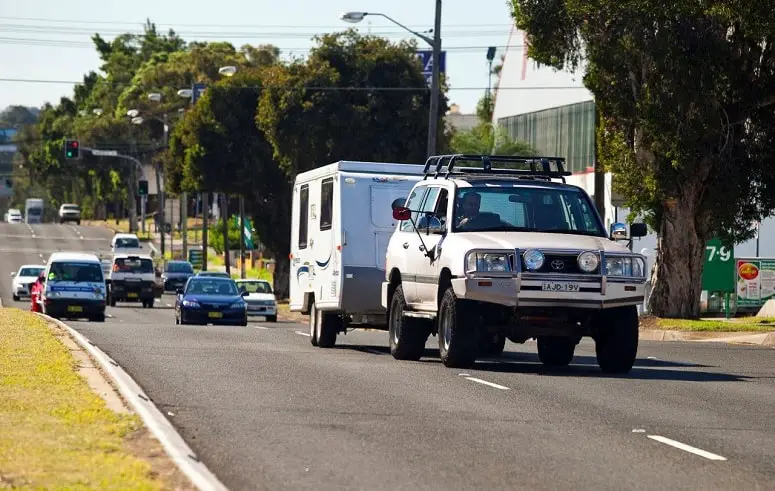
While on the topic of braking, it’s probably good to mention that your stopping time is longer now, even with the controller.
You can’t simply stop on a dime as you might have done without the trailer.
It’s essential that you teach yourself how to predict the traffic.
Here’s what most motorhome enthusiasts do: they assume traffic patterns ahead of time, generally on a 15-second basis.
For instance, if they spot a vehicle three cars ahead that’s riding their brakes, they can expect that the driver might pull onto an exit. This buys time in preparing to slow down.
Of course, what other motorists are thinking and planning on doing is impossible to know for sure, but observing the vehicles further ahead can help prepare you, and may even prevent the need for a hard stop.
This may sound like very focused driving, but keep in mind that you’re towing a 2,000-pound, if not more, camper behind you. You want to ensure your safety, as well as that of your passengers and your fellow motorists.
Familiarize Yourself With The Route
Before you get going, an extra tip I can give you is to familiarize yourself with your chosen route.
With the camper behind you, making a course correction can be tricky, especially if you’re driving through urban areas.
Enlist your smartphone for this task and try entering your destination into Google Maps. This will show you the route, and by choosing ‘street view,’ you get a 360-degree look at the surroundings.
Take notes of any narrow roads, tunnels, and overpasses, if there are any low bridges, and so on.
Once you’re on the road, you can keep it with you to help with the navigation. You could also buy a navigation system that has additional settings for trailers and RVs.
This can help you steer clear of any potential trouble spots on the road. Some may even let you know the proper speed for your car and camper.
Feel free to watch this YouTube video showing the benefits of using Google Maps.
7. Make Sure The Cargo Weight Is Positioned Right
Now that you’ve got your camper hitched, you’ve studied the route, checked the brakes, and ensured full visibility—it’s time to load up the trailer.
Since this is a small camper, you need to be careful where you place your cargo. Everything must be balanced, to ensure a smooth and safe ride. If there’s no balance, your trailer will tip either at the front axle or the rear, and you’ll be unable to tow it safely.
For small campers and trailers alike, you’ll want to place most of your cargo weight toward the front axle. Ideally, this should be about 60 percent in the front, and no more than 40 percent in the back.
Having too much in the back will lead to a tail-heavy camper, which causes serious rear-sway. The back end of the trailer becomes difficult to control, and will likely swing unpredictably.
It could whirl out of control when a large truck passes you, or a gust of wind takes you by surprise.
Placing too much weight at the front, near the hitch, could interfere with your ability to brake and accelerate.
Additionally, it causes early wear and tear on the suspension of your vehicle.
It can also cause tire damage if you exceed the recommended speed limit.
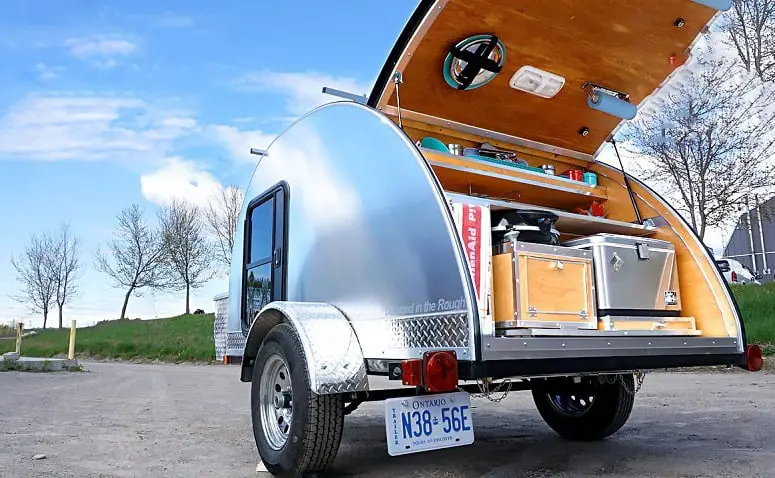
8. Pack Lightly
When traveling anywhere, we obviously can’t pack up all of our belongings, so you’re probably used to compromising.
But when going in a small camper, you’ll have to restrict yourself even further. You need to make sacrifices for everything to work.
This means packing less, but versatile, clothing that you can wear multiple times. Avoid stocking up on loads of food, and instead make a few extra pit stops.
And lastly, water.
We need water to avoid dehydrating while on the road, but water takes up a lot of weight and room. Ideally, we would like to stock up on multiple jugs to ensure that we have enough.
Realistically, though, you won’t be able to fit a lot in your camper.
Committing to a small camper means making some compromises. Take what you need for the journey, and stock up when you arrive at your destination.
9. Turning
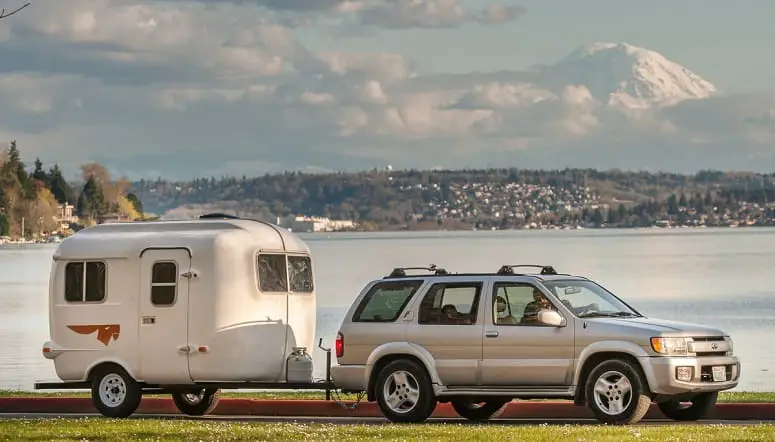
Although turning may seem like a scary thing, it’s really not.
The trailer will follow the path of your car. And since you’re working with a small camper, you’ll find it easy, with practice.
The general rule of thumb when it comes to turning is that the longer the trailer, the wider the turn.
Try to keep away from turns under 90 degrees, anything sharper than that could be an issue. Don’t be afraid to take up as much space as you need—as long as you’re not causing any harm.
In situations where you can’t avoid a sharp turn, just go as wide as the road permits. However, try to avoid the strategy of backing up to get more turning room.
Trailers can be tricky to back up, even the small ones, and you don’t want to test your skills on a narrow road.
When you’re turning, ease into the corner and take it slow. A camper usually has a high center of gravity, much higher than that of your vehicle. If you’re speeding into a turn that would otherwise be safe for just your car, your trailer could tip over.
10. Backing Up
Turning is one thing, backing up is another.
Fortunately, you have a small camper, so that eases the pressure a little. Still, you need to do some serious practice before hitting the road.
Backing up is not as natural as turning.
The camper won’t simply go the same way that you’re turning the wheel. But don’t worry, practice makes perfect.
On the steering wheel, you want to place your hand at the bottom and remember that turning the wheel to the left, makes you go left and vice versa.
As you’re backing up, you’ll notice that your car and camper will form a V-shape, pointing away from the direction of your turn. This is the tricky part. Going too fast without adjusting the steering wheel will lead to a lock-up, also known as a jackknife.
Take it slowly, and if the V-shape is getting sharper, go forward a bit and then back up again. Try to aim your wheels toward the axis that the camper should be on. Then keep going until you’re lined up.
For a visual guide, watch this video.
How To Park
There are plenty of ways to park, but there is one technique that never seems to fail.
Have you ever heard of “scooping?”
Find your desired parking spot, and drive slowly past it.
Now as you pass it, turn the wheel slightly to sort of dip in and out of it — think of “scooping” the spot. Doing this will put your camper in a much better starting angle.
Then as you’re exiting your scoop, turn your car away from the spot.
This will line up your camper, minimizing the need for too much turning when you back up. Continue going until you’re parked.
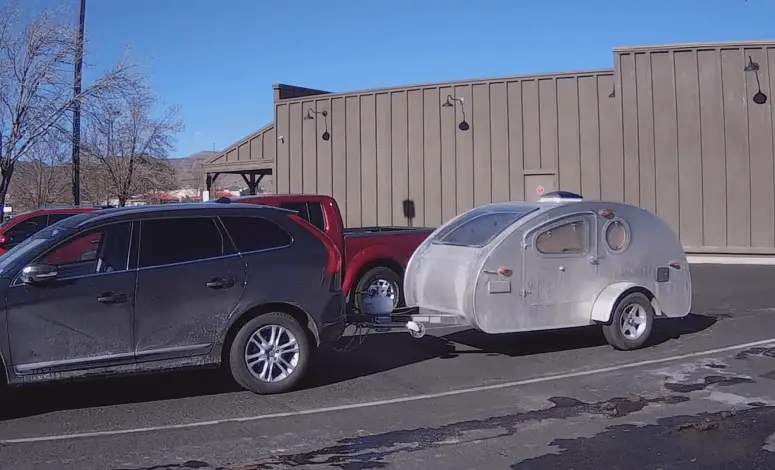
Enlist A Spotter For Assistance
We all need help at some point, but when backing up a camper, it becomes a necessity.
Get one of your passengers to stand in front of your car. From here, he or she can direct you as you’re backing up. Even with extended mirrors, you may still have blind spots.
Rear-vision cameras would also really come in handy when you’re backing up. Getting used to a screen as opposed to looking through the mirrors may take some time, but it will be worth it.
Pro Tip: until you feel 100 percent comfortable with backing up, avoid getting into situations where you feel pressure. Backing up a camper takes patience, and other motorists will likely get testy, which will only cause you further stress.
11. Up Hill And Down Dale
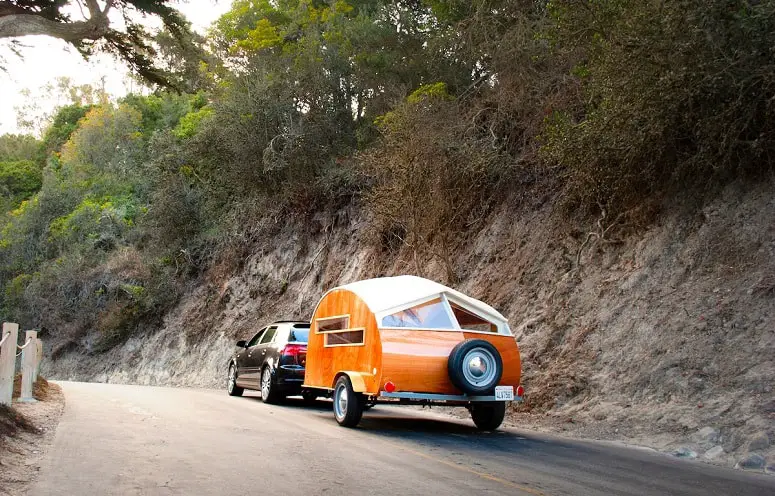
If your route takes you through steep hills and valleys, it can seem a bit stressful.
However, as long as you’re not pushing your tow ratings, you should do just fine. When going uphill, take your time and keep to the right.
Coming down, you need to be more cautious. Play it safe and don’t let your vehicle run out of control—keep your foot hovering over the brake pedal.
If your car is capable, try to employ engine braking.
Remove your foot from the throttle and put your vehicle in a lower gear. That way, you’re using the mechanical resistance to slow down, as opposed to the brakes.
If the hill is steeper, you must also apply the brakes. But be gentle! Braking too hard, especially in a turn, or in the wet, can cause you to jackknife, leading to an accident.
Keep it slow and steady. You could always turn on your hazards just to let other cars know that you’re taking it slow.
12. Trailer Sway
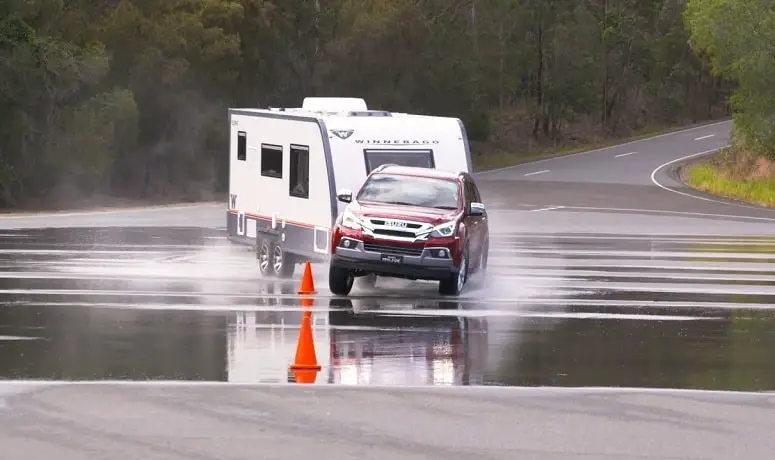
Trailer sway—I know this might sound grave, but it’s one of the real dangers of towing a camper, be it big or small.
One way to describe trailer sway is a dog wagging its tail so much that eventually, he stumbles.
When something pushes your camper, it starts a chain reaction into the tow vehicle.
This reaction causes the car and trailer to swerve, rapidly growing stronger, until the trailer and vehicle are both out of control. Luckily there are ways you can avoid it.
One way is to distribute the weight in the camper evenly, as I mentioned above. Also be careful not to overload the trailer.
Avoid driving on very windy days, if possible.
However small your camper, it’s still at the mercy of the wind, which will push unevenly on the camper and trigger a slight swing.
This will quickly escalate and spread to your vehicle, becoming almost impossible to keep under control.
Sometimes all it takes is a larger truck zooming by, hitting you with a burst of air. When it happens, do not counter steer to correct it! This will only enhance the sway force.
Speeding while towing can also cause trailer sway; speed limits are there for a reason: stick to them! Downhill inclines may cause unintentional increases in speed, again resulting in trailer sway.
Here’s what you should do:
- Stay calm—keeping cool is vital.
- Slow down—take your foot off the throttle.
- Don’t use your vehicle’s brakes, unless there is a danger of collision; this could make the sway worse.
- Gradually engage the manual trailer brake (if fitted)—this should pull back on your vehicle, helping to regain a straight line.
For more information on causes of trailer sway, and some handy hints, check out this YouTube video from RV Education 101.
13. Slow And Steady Wins The Race
If this is your first experience of towing, going slow may come naturally.
Hauling even a small camper can be scary at first, and you will need to monitor your speed.
This may sound ridiculous, but keeping near 40 miles per hour would be ideal. Going at a slow, steady pace, you’re ensuring that you have enough time and control to stop when you need to. Not to mention lowering the chances for trailer sway.
When driving on the highway, you can accelerate. However, don’t overdo it.
It’s better to get to your destination late and in one piece than not arrive at all. Check out the speed limits according to the AAA.
End Of The Road
Towing a small camper for the first time can seem scary and may stress you out.
However, by making sure that you’re well prepared, you’ll soon ease right into it.
Just remember to pack lightly and distribute the weight, with 60 percent at the front and always less than 40 percent in the back. Take it slow and don’t rush.
Practice backing up, turning, hitching, and unhitching before heading out, and enjoy your fantastic camper journey!
Do you have additional questions or do you have some extra tips for other readers? Please let us know in the comments below. And don’t forget to share if you found this list helpful!


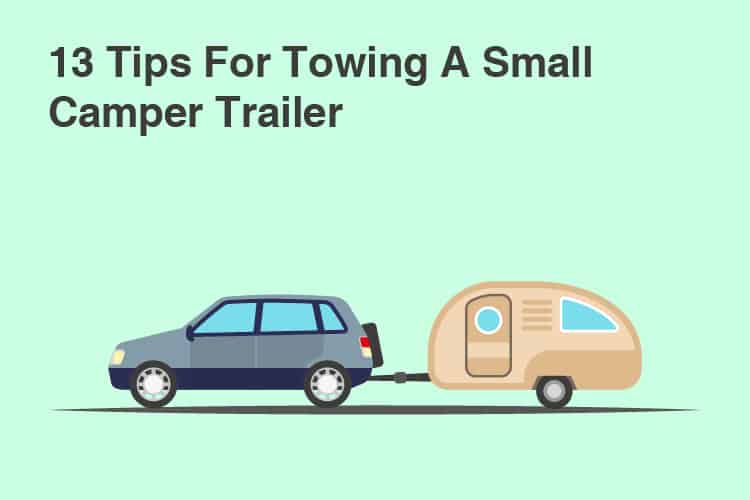

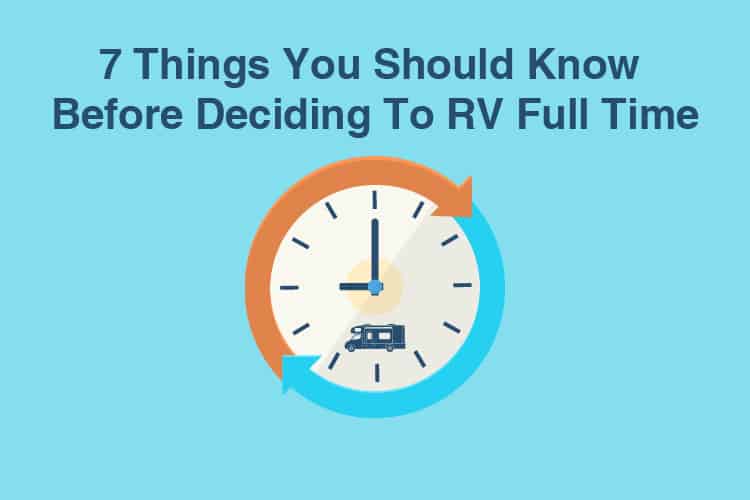
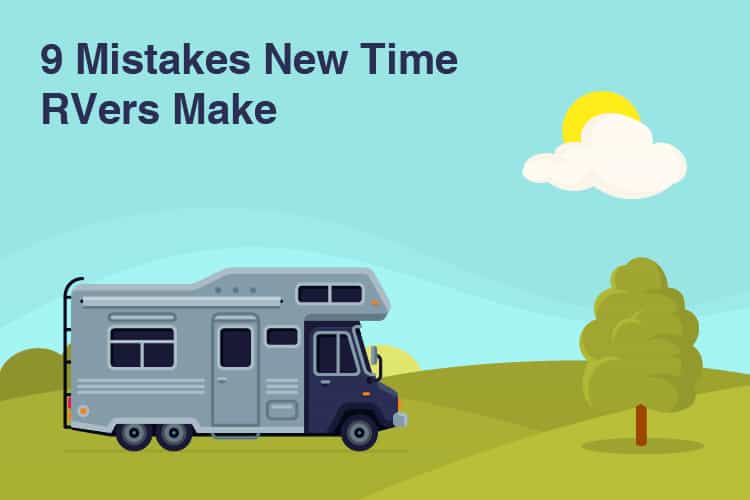

Any thoughts on Light camper trailers for Tesla Model Y? Thinking of going Cross country for summer in a Model Y! With Covid, Air BnBs and Motels seem far fetched!
Max
It’s good to know that you shouldn’t jackknife the trailer by not adjusting the wheel. I need to get a new trailer to put my dirt bikes on and I want my son to have the experience driving it. I’ll be sure to look out for good trailers that can hold my bikes.